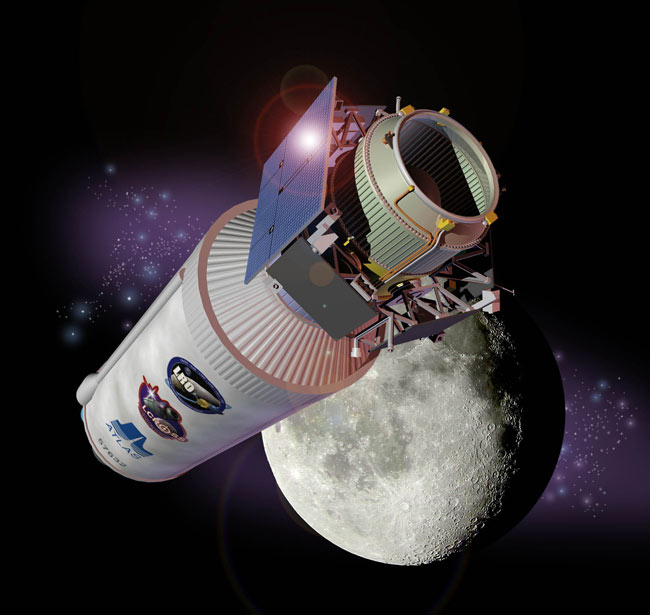Water on the Moon?

Recent headlines have announced a raging controversy amongscientists about whether there is actually water ice in the permanentlyshadowed craters near the lunar poles. Because these permanently shadowedregions are extremely cold (~100K) water ice is expected to be stable there ?even in the vacuum of space. If water is present, it will dramatically reducethe cost of a lunar base. The Lunar Crater Observing and Sensing Satellite(LCROSS) mission is intended to test for this water by impactingthe lunar surface with its empty rocket upper stage, and looking for waterin the ejected plume.
At issue is the evidence for water ice from neutron countsand radar observations of the polar regions. In the mid-1990s, Earth-based radarobservations of the polar regions detected areas of higher circularpolarization ratio (CPR). This is the ratio of the reflected radar signalhaving the same circular polarization as the incident beam to the reflectedsignal having the opposite polarization. High values of CPR tend to indicateblocky, irregular surfaces such as boulder-strewn fields or crater ejecta, butcan also result from low-loss scattering by water ice entrained in smoothersurface material such as soil or regolith. Large rocks and boulders mixed intothe regolith also can have a distinct signature. The high CPRs detected at thelunar poles seemed to correlate with crater floors in these regions, wheregeometry and orbital mechanics conspire to produce permanently shadowed regions.This effect has been observed on Mercury, where permanently shadowed cratersexhibit CPRs which resemble those from the icy Galilean satellites. The radarresults for the moon were thus interpreted to be due to similar effects.
The neutron detector on Lunar Prospector subsequently foundlow counts of epithermal neutrons over the polar regions as well, which aretypically indicative of hydrogen. However, it is not clear whether this ishydrogen in the form of pure water (H2O), hydroxyl (OH-, likely bound to minerals), or hydrogen (H+) implanted by thesolar wind. If the hydrogen is in the form of H2O or OH- bound to minerals, it could still be useful, but extraction will be moredifficult and costly.
The current controversy centers around recent radar observationsat higher resolution than the previous studies. These observations show highCPR's in crater walls and floors, but they are not correlated with thepermanently shadowed regions. They are correlated with the rocky surfaces andejecta blankets around young craters, and with the inner walls of some of thelarger craters. They definitely do not indicate large deposits of pure ice — there are no skating rinks on the Moon, as one scientist put it. And theneutron studies detect hydrogen, not water — so there are other ways to explainthose results too. The results also depend on how much solar wind implantedhydrogen is assumed to be present, as well as the exact locations and sizes ofthe permanently shadowed regions — which aren't actually very well known, sincewe cannot see them all from Earth. The two areas where the shadowed regions arebest constrained are within the craters Shackletonand Shoemaker.
Water ice remains consistent with the neutron studies, butonly in concentrations of around 0.4 to 1 percent by weight, as small chunksmixed into the regolith. Or, if the ice is trapped in small pores in the soilminerals, it could be as much as 10 to 20 percent. Surface roughness andneutron counts both vary on spatial scales much smaller than the instrumentscan resolve, creating additional uncertainty. So the interpretation depends oncertain assumptions, and can vary — it is still consistent with water ice mixedinto the soil, and possibly even large amounts, but more likely very smallamounts, if any at all.
The LCROSS mission is being optimized for 0.5 to 2 percentby weight of water in the soil — consistent with the neutron results. Thegeneral consensus at present is that the radar polarization in the polarregions is consistent with soil containing small amounts of ice, or could bedue to surface roughness effects. Because the polarization is not actuallycorrelated with the permanently shadowed regions, many are now leaning towardthe surface roughness hypothesis, but there are insufficient data at present toconclusively determine whether there is ice. A dry regolith is virtuallyindistinguishable from regolith containing tiny amounts of ice within andbetween mineral grains. This is why the radar experiments on Chandrayan and Lunar ReconnaissanceOrbiter (LRO) are being designed to understand the relationship between CPRand ice on the moon, and why the LCROSS mission is being sent to directly probethe surface and test these hypotheses through observation and experiment.
And that is how the scientific method deals withcontroversy.
Breaking space news, the latest updates on rocket launches, skywatching events and more!
- VIDEO: Moon 2.0: Join the Revolution
- The Greatest Lunar Crashes Ever
- All About the Moon
